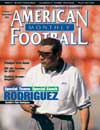AMERICAN FOOTBALL MONTHLY THE #1 RESOURCE FOR FOOTBALL COACHES
Article CategoriesAFM Magazine
|
Multiple Looks Create HavocUAM Defense: Stressing the Line of Scrimmage and Attacking the Offensive Line Every PlayHead Football Coach, University of Arkansas at Monticello © More from this issue We are often asked, "Just what is your base front and coverage?" When people who watch us play or opposing coaches ask, I know we are accomplishing our top priority of creating multiple looks. I believe our defensive system is one that is very simple to teach, and creates problems for opposing coaches (especially in preparation), plus it allows our players to be athletic, creative, and develop ownership. We have developed a teaching progression of both assignment and technique that enables us to create an infinite number of defensive looks. Our base defensive front is 4-3 with quarters coverage behind it. We flip our entire defensive front, which enables us to easily add some 46 and 3-4 looks to our package. Also, playing some man-free allows the ability to walk another man into the box in a manner that is a little differ....The full article can only be seen by subscribers.
|
|
|||||||
| HOME |
MAGAZINE |
SUBSCRIBE | ONLINE COLUMNISTS | COACHING VIDEOS |
Copyright 2025, AmericanFootballMonthly.com
All Rights Reserved





